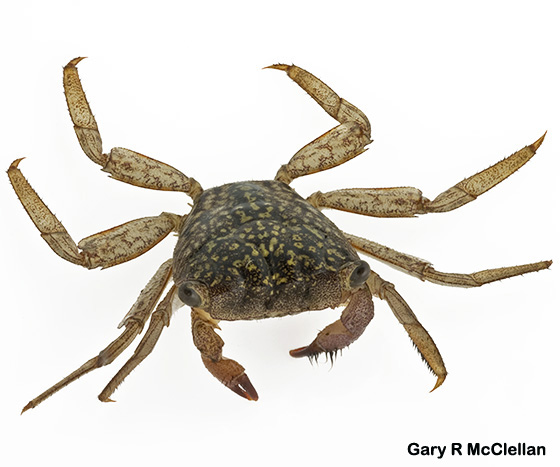Life History
The mangrove tree crab has a life cycle that includes a larval stage and the adult form (Cuesta et al. 2005). The larval period is about a month long and divided into four stages of zoea that are 4 to 6 days in duration each and a final megalopa stage that looks similar to the adult (Cuesta et al. 2005, Warner 1967). Larval form of the mangrove tree crab is very vulnerable to predation by small fish. During this time, the vast majority of mortality occurs (Warner 1967).
The carapace
length in the first stage of zoea is about 0.3 mm, and it will grow
to about 0.47 mm in the final zoea and 0.69 mm in the megalopa
(Cuesta et al. 2005). The mangrove tree crab will reach
maturity when its carapace width is about 12 mm. At this
point, the crabs begin reproduction (Warner 1967). They grow
through molting cycles when they shed their exoskeleton and the new
one begins to harden. The process takes several days.
Mature females usually reproduce once or twice between molting.
When a carapace width of about 12 mm is reached, the amount of
energy used in reproduction causes the growth of female mangrove
tree crabs to slow down compared to the growth of males.
Before this, they grow at the same rate (Warner 1967).
Mature
mangrove tree crabs will mate and reproduce year-round. Their
breeding cycles were connected to moon phases with eggs most
commonly hatching during full moons and new moons (Cuesta et al.
2005, Warner 1967). This is not a very common trait in
crustaceans. It’s possible that it is related to changes in
the tide that give Mangrove tree crabs a possible advantage. (Warner
1967).
Mangrove tree
crabs will copulate with males on top. The male holds on to
the females with its legs and puts its pleopod up to the female’s
genitalia (Warner, 1967). Once developed, the eggs remain
attached to the female, and it will be fourteen to sixteen days
until they are hatched (Cuesta et al. 2005, Warner, 1967).
The eggs are spherical with a diameter of about 600 µm. The
embryo can first be seen on the fourth day of development. By
the tenth day the heart of the embryo is already beating. On
day fourteen, the yolk is almost completely gone, and it is ready to
hatch (García-Guerrero and Hendrickx 2004). When the eggs are
to begin hatching, the females will move out to the edge of the
swamp and down into the water. They will then shake in order
to disperse the hatching larvae. They will do this for a
minute or two until all the eggs have hatched. (Warner 1967).
Go back to the Home page or continue to the Interactions page.

